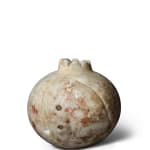Graeco-Roman
A Graeco-Roman marble pomegranate, circa 1st century AD
Marble
Height: 8.5 cm
Of spherical form with serrated opening, the body incised with two grooves, with traces of red pigment remaining, originally carved for use as a model of an attribute held by...
Of spherical form with serrated opening, the body incised with two grooves, with traces of red pigment remaining, originally carved for use as a model of an attribute held by a life-size marble statue of a goddess
Provenance
Swedish private collection, acquired in Stockholm in the 1970s
Bonhams, 16 April 2015, lot 127
American private collection, acquired from the aboveLiterature
The pomegranate was associated with agrarian cults, fertility and funerary rites and in particular with the Eleusinian mysteries, relating to the goddesses Persephone and Demeter. Persephone was tricked by Hades into eating a pomegranate, thus dooming her to spend one third of the year, symbolising Winter, in the Underworld.Pausanias describes the chryselephantine statue of the goddess Hera at Argos as holding a pomegranate in one hand and a sceptre in the other. With regards to the pomegranate, he describes, 'about the pomegranate I must say nothing, for its story is somewhat of a holy mystery' (Description of Greece, 2.17.4-6).



